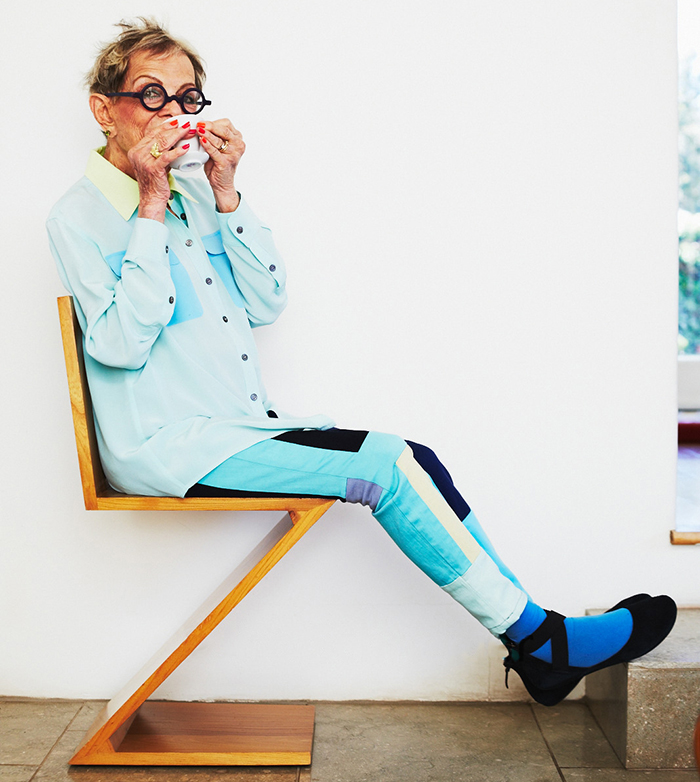
Deborah Sussman, June 2014 (Photographer: Jiro Schneider)
The death this week of Deborah Sussman, who passed away in Los Angeles at age 83, is notable in part because she was a woman able to carve out a vibrant and successful career in a field traditionally dominated by men. Sussman lived long enough to see her career receive critical attention, most recently as the subject of a retrospective exhibition, Deborah Sussman Loves LA, held last winter at Los Angeles’ Woodbury University Hollywood Gallery.
That love is reciprocated. As the show’s title suggests, she is rapidly becoming canonized in Southern California; but this Los Angeles love story often overshadows one of the key aspects of Sussman’s career — her rise and influence as a woman working in the male-dominated world of postwar design.
For all the Los Angeles boosterism, Sussman’s roots lie in Brooklyn, where she was born in 1931. From an early age, Sussman was pulled between her early desire to become an actress and her fascination with art and design. Although educated at Bard College — where she studied painting and acted in student productions — she was drawn to the eclectically avant-garde milieu of Black Mountain College where she spent a summer studying. But Sussman’s real awakening came during her junior year, when she decided to transfer her studies to the “New Bauhaus” at the Illinois Institute of Technology: what began as a short break from Bard grew into a three-year stay.
At IIT, Sussman accumulated mentors, including the Swiss trained Hugo Weber (1918-1971) and the visionary architect and engineer Konrad Wachsmann (1901-1980). Skilled at drawing and gifted at model-making, Sussman stood out from her peers and was soon recruited by Charles Eames, who visited the school in 1953. For Sussman, the opportunity to work with the Eamses was “like being told you’re going to heaven and you’re to live there.”
Arriving without commitments, responsibilities, dependents or emotional ties, Sussman was thrust into a variety of roles, ranging from graphic designer to filmmaker and, ultimately, to the confidante of Ray Eames. Indeed, they fluidly moved between appointed work roles and, in later years, Sussman made a point of identifying for scholars the contributions of Ray Eames to the team’s work. Sussman’s long tenure with the Eameses undoubtedly helped her subsequent career, when she set up her own design studio. “Working at the Eames office,” she would later note, “was like getting a certification of value.” Perhaps ironically, however, those ties now obscure Sussman’s own early work; like her good friend Ray, Sussman found her own designs often subsumed under the larger Eames studio label.
Indeed, after two lengthy stints working with the Eameses — first from 1953 to 1957 and again from 1961 to 1967 — Sussman grew to a greater maturity, taking on independent work and officially leaving the Eames studio to establish Sussman and Company in 1968. She would later become a pioneer in environmental design, a move considerably aided by collaboration with her husband, the architect Paul Prejza. Heading the new firm Sussman/Prezja also brought her into more contact with the male-dominated architecture and design establishment, what she called “the old boys club of designers in Los Angeles.” To Sussman it seemed like “they got all the jobs. They did all the work. They were the elite.”
Perhaps Deborah Sussman’s best-known work — for the 1984 Los Angeles Olympics — is often associated with the California New Wave movement, but it also thrust her into an uneasy leadership role. As she recalls, being in charge of some 150 designers — most of whom were men — required subtle but firm leadership. “The male mafia” with whom she worked were dubious, and she remembered well an early “presentation that I made to everybody … and I had selected this palette of color and here I am this little female telling them what colors they had to use, and they were all sort of stone-faced … And they said, but where’s the gray? We need gray with those colors.” But Sussman’s colorful vision for the Olympics would prevail, and her image for the city helped seal Los Angeles’s own design identity. For this work and for so much more, she will be greatly missed and long remembered — a pioneer in the fullest sense.
